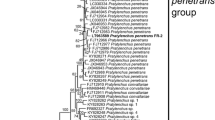Abstract
A technique based on the use of specific primers for polymerase chain reaction (PCR) was developed for the identification of the stem and bulb nematode belonging to the Ditylenchus dipsaci species complex. The internal transcribed spacer region ITS1 and ITS2, the gene 5.8 S and part of genes 18 S and 26 S of twenty populations of the D. dipsaci species complex belonging to both D. dipsaci sensu stricto and Ditylenchus sp. B (corresponding to populations of giant individuals associated to Vicia faba) and three congeneric species were amplified with two universal ribosomal primers. PCR-amplified DNA samples were digested with five restriction enzymes in order to reveal some polymorphism allowing the identification of D. dipsaci populations associated with Fabaceae seeds. The polymorphism among species was confirmed by the sequencing of the PCR products. A primer (DdpS2) was designed in a region conserved in all populations of both D. dipsaci sensu stricto and D. sp. B studied in the present work. The other Anguinidae species (except a few species from Central Asia associated to Astereaceae and D. sp. G associated to Plantago maritima) differ in two to four nucleotides at the 3′ extremity of this region. This sequence portion coincides with a TspEI restriction site. In combination with a primer located in the ribosomal region, this first primer is a good candidate for identification by PCR of populations of the D. dipsaci species complex found in Fabaceae seeds. A second primer (DdpS1) was designed in a similar way and was specific to D. dipsaci sensu stricto. The utility of these two sets of primers is discussed against the background of quarantine regulation.




Similar content being viewed by others
Abbreviations
- rDNA:
-
Ribosomal DNA
- SCAR:
-
Sequence characterized amplified regions
References
Ait Ighil, M. (1983). Variabilité physiologique de deux races, normales et géantes de Ditylenchus dipsaci (Kühn) Fil. (Nematoda: Tylenchida) parasite de Vicia faba L. Thesis ENSA Rennes Université de Rennes I.
Amiri, S., Subbottin, S. A., & Moens, M. (2002). Identification of the beet cyst nematode Heterodera schachtii by PCR. European Journal of Plant Pathology, 108, 497–506.
Caubel, G., & Pedron, D. (1976). Distribution géographique du nématode des tiges Ditylenchus dipsaci (Kuhn) Fil., en culture de légumineuses fourragères. Sciences Agronomiques Rennes, 183–188.
Cayrol, J. C. (1970). Contribution à l’étude de la biologie de Ditylenchus myceliophagus Goodey, 1958, nématode édaphique mycetophage. Revue d’Ecologie et de Biologie du Sol, 3, 331–350.
Esquibet, M., Bekal, S., Castagnone-Sereno, P., Gautier, J. P., Rivoal, R., & Caubel, G. (1998). Differentiation of normal and giant Vicia faba population of the stem nematode Ditylenchus dipsaci: agreement between RAPD and phenotypic characteristics. Heredity, 81, 291–298.
Esquibet, M., Grenier, E., Plantard, O., Abbad Andaloussi, F., & Caubel, G. (2003). DNA polymorphism in the stem nematode Ditylenchus dipsaci: Development of diagnostic markers for normal and giant races. Genome, 46(6), 1077–1083.
Ferris, V. R., Ferris, J. M., & Faghihi, J. (1993). Variation in spacer ribosomal DNA in some cyst forming species of plant parasitic nematodes. Fundamental and Applied Nematology, 16(2), 177–184.
Gray, F. A., Williams, J. L., Griffin, G. D., & Wilson, T. E. (1994). Distribution in the western United States on Alfalfa and cultivar reaction to mixed populations of Ditylenchus dipsaci and Aphelenchoides ritzemabotzi. Journal of Nematology, 26(4S), 705–719.
Hooper, D. J. (1984). Observation on stem nematode, Ditylenchus dipsaci, attacking field beans, Vicia faba. Rothamsted Experimental Station Report (1983), 239–260.
Leal-Bertioli, S. C. M., Tenente, R. C. V., & Bertoli, D. J. (2000). ITS sequence of populations of the plant-parasitic nematode Ditylenchus dipsaci. Nematology Brasileira, 24(1), 83–85.
Palmer, H. M., Atkinson, H. J., & Perry, R. N. (1991). The use of DNA probes to identify Ditylenchus dipsaci. Revue de Nematologie, 14(4), 625–628.
Marek, M., Zouhar, M., Rysanek, P., & Havranek, P. (2005). Analysis of ITS sequences of nuclear rDNA and development of a PCR-based assay for the rapid identification of the stem nematode Ditylenchus dipsaci (Nematoda: Anguinidae) in plant tissues. Helminthologia, 42(2), 49–56.
Milano de Tomasel, M. C., & McIntyre, G. A. (2001). Distribution and biology of Ditylenchus dipsaci and Aphelenchoides ritzemabosi in alfalfa grown in Colorado. Nematropica, 31, 11–16.
Powers, T. O., Szalanski A. L., Mullin P. G., Harris, T. S., Bertozzi T., & Griesbach, J. A. (2001). Identification of seed gall nematodes of agronomic and regulatory concern with PCR-RFLP of ITS1. Journal of Nematology, 33(4), 191–194.
Sambrook, J., Fritsch, E. F., & Maniatis, T. (1989). Molecular cloning: a laboratory manual. (2nd ed.). New York: Cold Spring Harbor Laboratory Press, Cold Spring Harbor.
Sturhan, D., & Brzeski, M. W. (1991). Stem and bulb Nematodes, Ditylenchus spp. In W. R. Nickle (Ed.), Manual of agricultural nematology (pp. 423–464). New York: Marcel Dekker.
Subbotin, S. A., Madani, M., Krall, E., Sturhan, D., & Moens, M. (2005). Molecular diagnosis, taxonomy, and phylogeny of the stem nematode Ditylenchus dipsaci species complex based on the sequences of the internal transcribed spacer-rDNA. Phytopathology, 95, 1308–1315.
Subbotin, S. A., Krall, E. L., Riley, I. T., Chizhov, V. N., Stalens, A., De Loose, M., & Moens, M. (2004). Evolution of the gall-forming plant parasitic nematodes (Tylenchida: Anguinidae) and their relationships with hosts as inferred from Internal Transcribed Spacer sequences of nuclear ribosomal DNA. Molecular Phylogenetics and Evolution, 30, 226–235.
Thompson, J. D., Higgins, D., & Gibson, T. J. (1994). CLUSTAL W: Improving the sensitivity of progressive multiple sequence alignment through sequence weighting, positions-specific gap penalties and weight matrix choice. Nucleic Acids Research, 22, 4673–4680.
Vrain, T. C., Wakarchuk, D. A., Levesque, A. C., & Hamilton, R. I. (1992). Intraspecific rDNA restriction fragment length polymorphism in the Xiphinema americanum group. Fundamental and Applied Nematology, 15(6), 563–573.
Wang, X., Bosselut, N., Castagnone, C., Voisin, R., Abad, P., & Esmenjaud, D. (2003). Multiplex polymerase chain reaction identification of single individuals of the longidorid nematodes Xiphinema index, X. diversicaudatum, X. vuittenezi, and X. italiae using specific primers from ribosomal genes. Phytopathology, 93(2), 160–166.
Wendt, K. R., Vrain, T. C., & Webester, J. M. (1993). Separation of three species of Ditylenchus and some host races of D. dipsaci by restriction fragment length polymorphism. Journal of Nematology, 25(4), 555–563.
Zijlstra, C. (2000). Identification of Meloidogyne chtwoodi, M. fallax and M. hapla based SCAR-PCR: a powerful way of enabling reliable identification of populations or individuals that share common traits. European Journal of Plant Pathology, 106, 639–643.
Acknowledgements
This study was supported by a CTPS Programme (Comité Technique Permanent de la Selection des plantes cultivées) of the French Ministry of Agriculture (Ministère de l’Agriculture, de l’Alimentation, de la Pêche et des Affaires Rurales) entitled ‘Mise au point d’un test PCR pour la détection sur semences de luzerne du nématode Ditylenchus dipsaci’. MK was supported by a postdoctoral fellowship from Institut National de la Recherche Agronomique (INRA). We thank Alex Mc Donald (Potchefstroom, Republic South Africa) for providing the D. africanus nematode isolate, and Jean-Pierre Paulin for critical reading of the manuscript.
Author information
Authors and Affiliations
Corresponding author
Rights and permissions
About this article
Cite this article
Kerkoud, M., Esquibet, M., Plantard, O. et al. Identification of Ditylenchus species associated with Fabaceae seeds based on a specific polymerase chain reaction of ribosomal DNA-ITS regions. Eur J Plant Pathol 118, 323–332 (2007). https://doi.org/10.1007/s10658-006-9092-6
Received:
Accepted:
Published:
Issue Date:
DOI: https://doi.org/10.1007/s10658-006-9092-6




